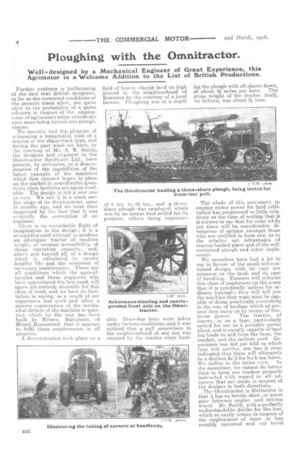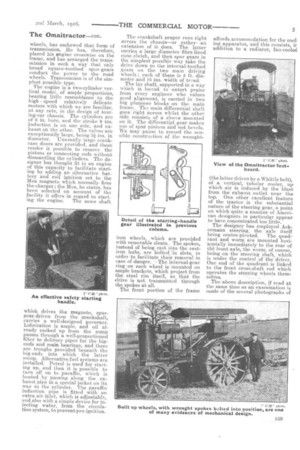Ploughing with the Omnitractor.
Page 4

Page 5

Page 6

If you've noticed an error in this article please click here to report it so we can fix it.
Well-, designed by a Mechanical Engineer of Great Experience, this Agrimotor is a Welcome Addition to the List of British Productions.
Further evidence is forthcoming of the fact that British designers, so far as the restricted conditions of the present times allow, are quite alive to the probability of a great advance in respect of the employment of agrimotors when swords are once more being turned into ploughshares.
We recently had the pleasure of witnessing a remarkable trial of a tractor of the chain-track type, and during the. past week we have, by the courtesy of Mr. A. K. Smith, the designer and engineer to the Omnitractor Syndicate Ltd., been present, by invitation, at a demonstration of the capabilities of the latest example of the machines which that concern hopes to place on the market in considerable quantities when facilities are again available. The design is not a new one in toto. We saw it in a much earlier stage.of its development, some 18 months ago, and we were then impressed by the fact that it was evidently the conception of an engineer.
There is no remarkable flight of imagination in the design ; it is a straightforward attempt to produce an oil-engine tractor of medium weight, of unusual accessibility, of cheap operating capacity, and, above and, beyond all, of a design which is calculated to ensure lengthy life and the minimum of necessary maintenance. These are all conditions which the agriculturalist and those engineers who have appreciated the last need, will agree are entirely desirable for this class of work, and we have no hesitation in saying, as a result of our experience last week and after a minute examination of the mechanical details of the machine in question which by the way has been built by Messrs. Martineau, of Hemel Hempstead, that it appears to fulfil these requirements in all respects.
A demonstration took place on a field of heavy, clayish land on high ground in the neighbourhood of Boxmoor by the courtesy of a local farmer. Ploughing was at a depth of 8 ins. to 8Ains., and a threeshare-plough was employed, which was by no means best suited for its purpose, others being unproeur able. Draw-bar tests were taken under various conditions, and it was noticed that a pull somewhere in the neighbourhood of one ton was exerted by the tractor when hau ing the plough with all shares dawn, at about 3* miles per hour. The gross weight of the tractor itself, we believe, was about 31 tons.
The Whole of this movement to employ motor power for land cultivation has progressed so little relatively at the time of writing that it is correct to say that for some while yet there will be considerable divergence of opinion amongst. those who are entitled to form one, as to the relative net advantages of tractor-hauled plant and of the selfcontained plough and other implements.
We ourselves have had a lot to say in favour of the small self-con• tamed design, with its very low pressure on the land, and its case of handling. Farmers will criticize this class of implement on the score that it is practically useless for ordinary haulage ; they will tell you the machine they want must be capable of doing practically everything in the way of haulage which at present they carry on by means of livehorse power. The tractor, of course, is, as a type, particularly suited for use as a portable power plant, and is equally capable of haul ing loads to and from the farm, the market, and the railway yard. Experience has not yet told us which type will survive, .nor has it even indicated that there will ultimately be a distinct field for both maqiines. We incline to the latter view. In the meantime, we cannot do better than to keep our readers properly instructed with regard to all advances that are made in respect of the designs in both directions.
The Omnitractor is distinctive in that it has no bevels, skew, or worm gear between engine and driving wheel. Hr. Smith, with a perfectly understandable dislike for the loss, which so easily occurs in respect of the employment of more or less roughly mounted and cut bevel wheels, has eschewed that form of transmission. He has, therefore, placed his engine crosswise on the frame, and has arranged the transmission in such a way that only broad square-toothed spur-gears conduct the power to the road wheels. Transmission is of the simplest possible type.
The engine is a two-cylinder vertical model, of ample proportions, bearing little resemblance to the high speed relatively delicate motors with which we are familiar, at any rate, in the design of touring-car chassis. The cylinders are of 6 in. bore, and the stroke 9 ins. Induction is on one side, and exhaust on the other. The valves are exceptionally large, being a ins, in diameter. Unusually large crankcase doors are provided, and these render it possible to remove the pistons or connecting rods without dismantling the cylinders. The designer has thought fit in an engine of this capacity to facilitate starting by adding an alternative battery and coil ignition set to the Men magneto which normally fires the charges ; the Mea, he states, has been selected on account of the facility it offers in regard to starting the engine. The same shaft which drives the magneto, spurgear-driven from the crankshaft, carries a well-designed governor. Lubrication is ample, and oil already sucked up from the sump passes through a well-proportioned filter to delivery pipes for the bigends and main bearings, and there are troughs provided beneath the big-ends into which the latter snoop, Alternative fuel systems are installed. Petrol is used for starting up, and then it is possible to turn off on to paraffin, which is heated by passing along the exhaust pipe in a special jacket on its way to the cylinder. The paraffin induction pipe is fitted with an extra air inlet, which is adjustable, and also with a simple device for injecting water, from the circulation system, to prevent pre-ignition.
The crankshaft proper runs right across the chassis—or rather—an extension of it does. The latter carries a large diameter fibre-lined cone clutch, and then spur gears in the siMplest possible way take the drive down to the internal-toothed gears on the two main driving .wheels ; earl' of these is 5 ft. diameter and 16 ins, width of tread.
The lay shaft, supported in a way which is bound to extort praise from .every engineer who values good alignment, is carried in two .big plummer blocks on the main frame. The Main differential shaft goes right across whilst the other side consists of a sleeve mounted on it. The differential gear makes use of spur pinions and not bevels. We may pause to record the sensible construction of the wrought
iron wheels, which are provided
with removable cleats.spokes, instead of being cat ito the eastiron hubs, are belted •,-in slots, in order to facilitate their removal in case of danger. The internal-gear ring on each wheel is mounted on ample brackets, whichproject from the steel rim itself, so that the drive is not transmitted through the spokes at all.
The front portion of the frame affords accommodation for the cool ing apparatus, and this consists, it addition to a radiator, fan-cooled
the latter driven by a Whittle belt), of a vertical, tubular cooler, up which air is induced by the blast. from the-exhaust outlet near the top. One other excellent feature of the tractor is the eubstantial nature of the steering gear, a point on which quite a number of American designers in particular appear to have concentrated too" little.
The designer has employed Ackermann steering, the axle itself being centre-pivoted. The quadrant and worm are mounted hod.tontally immediately to the rear of tho front axle; the worm., of course, being on the steering 'shaft, which is under the Control of the.driver. One end of the quadrant is linked to the front cross-shaft rod which operates the steering wheels them The-above description, if read at the same time as an examination is made of the several photographs of
the interesting machine, which we reproduce, will serve to emphasize in the minds of our readers the good opinion which we ourselves have pronounced of the structural features of this machine.
Stock-size Material Used.
In order to facilitate replacement, wherever it has been in any way possible, component parts have been manufactured from stock material, which it should be easy to procure from any wholesale or agricultural ironmongers.
There is a distinct absence of complicated castings and forgings, -which in itself is evidence of the desire to meet the need for a machine which can be looked after by somebody who is not a mechanic.
A Safety Starting Gear.
One of our pictures shows the arrangement of the footboard of the tractor ; another, in detail, depicts the special safety-starting device, which permits the engine to kick back and in doing so to throw out a dog clutch, so rendering whoever is starting up the engine immune from risk of damage.
We need add little to the actual performance of the machine. The plough, as we have already stated, was by no means of a type which was calculated to give best results with regard to the turning over of the land—that was not what we went to see. The tractor could haul we'll, and it was very easy to manipulate at the headlands, the steering in particular rendering it possible to turn the tractor very nearly in its own length.
We understand that the Omnitractor is to be marketed, at war prices, at about £500. It will per
haps be interesting for us to add the following few figures which are supplied by the company as being typical of the work which the machine is capable of undertaking :— Duty and Capacity of Tractor.
Ploughing.—Four 12 in. ploughs at 2i miles per hour, equal, with turns, to one acre per hour or 10 acres, per day.
Reaping—Two 8 ft. binders, 40 acres per day.
Mowing. — Three mowing machines, 40 acres per day.
Harrowing.-50 acres per day. Seeding.-50 acres per day. Discing.—Four 8 ft. discs with drag harrows, 80 acres per day. Threshing.—Takes Blower thre
sher; 1500 bushels per day.
Is also useful for working road formers and scrapers, stubbing roots, and clearing ground. Fuel consumption about 21 gallons per acre when ploughing (greatest). Less for traction and other work. Cost per acre, 4s.
Note. — Fuel consumption is largest for ploughing or drawing heavy loads on had roads ; for other farm work or turning machinery, it is less than half the above.
The amount ploughed will, of course, be more or leSs according to the density of the soil, etc. The above estimate is for fairly heavy ground.
The prices of fuel are approximate for England.




















